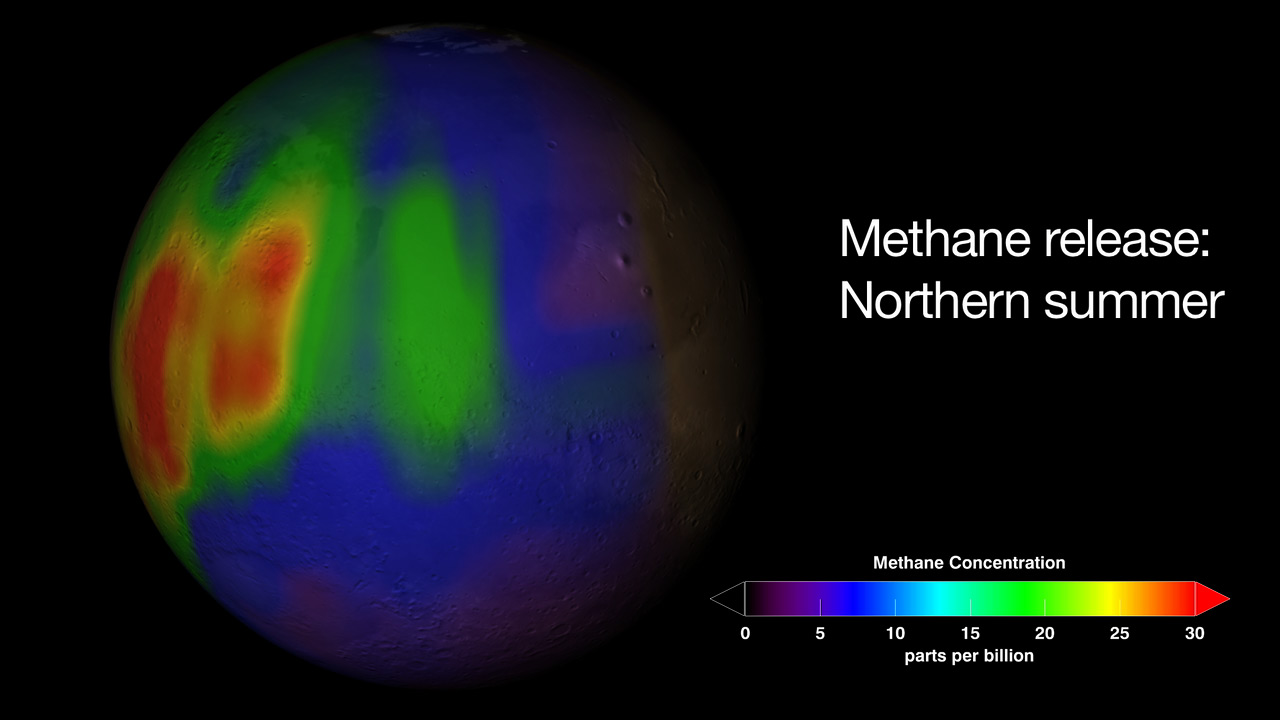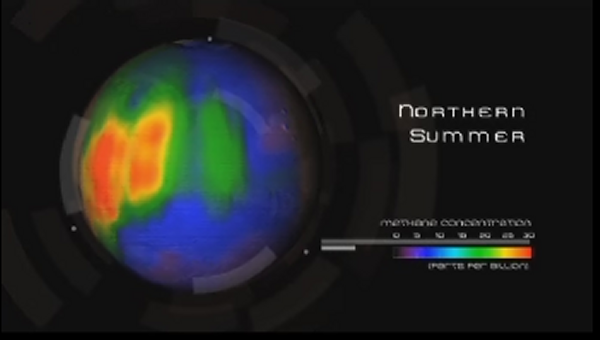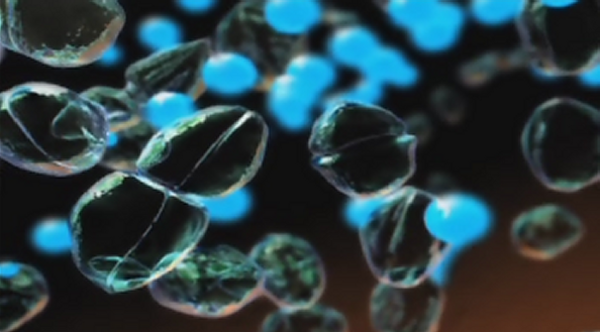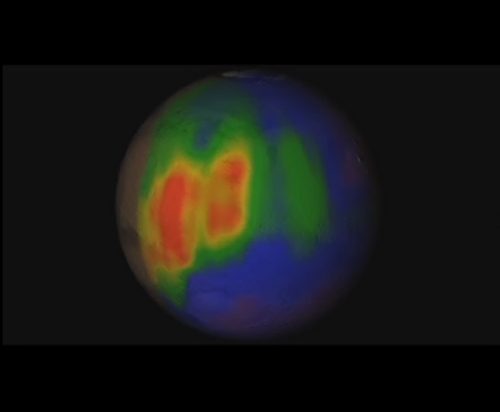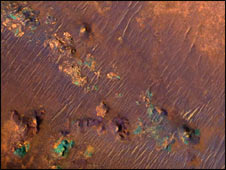|
The Enigmas on Mars 52 |
|||||
|
Reveals the Red Planet is not a Dead Planet ....
This image shows concentrations of Methane discovered on Mars. Martian
Methane Reveals the Red Planet is not a Dead
Planet Mars today is a world of cold and lonely deserts, apparently without life of any kind, at least on the surface. Worse still, it looks like Mars has been cold and dry for billions of years, with an atmosphere so thin, any liquid water on the surface quickly boils away while the sun's ultraviolet radiation scorches the ground. But there is evidence of a warmer and wetter past -- features resembling dry riverbeds and minerals that form in the presence of water indicate water once flowed through Martian sands. Since liquid water is required for all known forms of life, scientists wonder if life could have risen on Mars, and if it did, what became of it as the Martian climate changed. New research reveals there is hope for Mars yet. The first definitive detection of methane in the atmosphere of Mars indicates the planet is still alive, in either a biologic or geologic sense, according to a team of NASA and university scientists. "Methane is quickly destroyed in the Martian atmosphere in a variety of ways, so our discovery of substantial plumes of methane in the northern hemisphere of Mars in 2003 indicates some ongoing process is releasing the gas," said Dr. Michael Mumma of NASA's Goddard Space Flight Center in Greenbelt, Md. "At northern mid-summer, methane is released at a rate comparable to that of the massive hydrocarbon seep at Coal Oil Point in Santa Barbara, Calif." Methane -- four atoms of hydrogen bound to a carbon atom -- is the main component of natural gas on Earth. It's of interest to astrobiologists because organisms release much of Earth's methane as they digest nutrients. However, other purely geological processes, like oxidation of iron, also release methane. "Right now, we don’t have enough information to tell if biology or geology -- or both -- is producing the methane on Mars," said Mumma. "But it does tell us that the planet is still alive, at least in a geologic sense. It's as if Mars is challenging us, saying, hey, find out what this means." Mumma is lead author of a paper on this research appearing in Science Express Jan. 15. If microscopic Martian life is producing the methane, it likely resides far below the surface, where it's still warm enough for liquid water to exist. Liquid water, as well as energy sources and a supply of carbon, are necessary for all known forms of life. "On Earth, microorganisms thrive 2 to 3 kilometers (about 1.2 to 1.9 miles) beneath the Witwatersrand basin of South Africa, where natural radioactivity splits water molecules into molecular hydrogen (H2) and oxygen. The organisms use the hydrogen for energy. It might be possible for similar organisms to survive for billions of years below the permafrost layer on Mars, where water is liquid, radiation supplies energy, and carbon dioxide provides carbon," said Mumma. "Gases, like methane, accumulated in such underground zones might be released into the atmosphere if pores or fissures open during the warm seasons, connecting the deep zones to the atmosphere at crater walls or canyons," said Mumma.
Scientists don't yet know enough to
say with certainty what the source of the
Martian methane is, but this artist's concept
depicts a possibility. In this illustration,
subsurface water, carbon dioxide and the
planet's internal heat combine to release
methane. Although we don’t have evidence on Mars
of active volcanoes today, ancient methane
trapped in ice "cages" might now be released.
"Microbes that produced methane from hydrogen and carbon dioxide were one of the earliest forms of life on Earth," noted Dr. Carl Pilcher, Director of the NASA Astrobiology Institute which partially supported the research. "If life ever existed on Mars, it's reasonable to think that its metabolism might have involved making methane from Martian atmospheric carbon dioxide." However, it is possible a geologic process produced the Martian methane, either now or eons ago. On Earth, the conversion of iron oxide (rust) into the serpentine group of minerals creates methane, and on Mars this process could proceed using water, carbon dioxide, and the planet's internal heat. Although we don’t have evidence on Mars of active volcanoes today, ancient methane trapped in ice "cages" called clathrates might now be released. The team found methane in the atmosphere of Mars by carefully observing the planet over several Mars years (and all Martian seasons) with NASA's Infrared Telescope Facility, run by the University of Hawaii, and the W. M. Keck telescope, both at Mauna Kea, Hawaii. The team used spectrometer instruments attached to the telescopes to make the detection. Spectrometers spread light into its component colors, like a prism separates white light into a rainbow. The team looked for dark areas in specific places along the rainbow (light spectrum) where methane was absorbing sunlight reflected from the Martian surface. They found three such areas, called absorption lines, which together are a definitive signature of methane, according to the team. They were able to distinguish lines from Martian methane from the methane in Earth's atmosphere because the motion of the Red Planet shifted the position of the Martian lines, much as a speeding ambulance causes its siren to change pitch as it passes by. "We observed and mapped multiple plumes of methane on Mars, one of which released about 19,000 metric tons of methane," said Dr. Geronimo Villanueva of the Catholic University of America, Washington, D.C. Villanueva is stationed at NASA Goddard and is co-author of the paper. "The plumes were emitted during the warmer seasons -- spring and summer -- perhaps because the permafrost blocking cracks and fissures vaporized, allowing methane to seep into the Martian air. Curiously, some plumes had water vapor while others did not," said Villanueva. According to the team, the plumes were seen over areas that show evidence of ancient ground ice or flowing water. For example, plumes appeared over northern hemisphere regions such as east of Arabia Terra, the Nili Fossae region, and the south-east quadrant of Syrtis Major, an ancient volcano 1,200 kilometers (about 745 miles) across. It will take future missions, like NASA's Mars Science Laboratory, to discover the origin of the Martian methane. One way to tell if life is the source of the gas is by measuring isotope ratios. Isotopes are heavier versions of an element; for example, deuterium is a heavier version of hydrogen. In molecules that contain hydrogen, like water and methane, the rare deuterium occasionally replaces a hydrogen atom. Since life prefers to use the lighter isotopes, if the methane has less deuterium than the water released with it on Mars, it's a sign that life is producing the methane. The research was funded by NASA's Planetary Astronomy Program and the NASA Astrobiology Institute. SOURCE: NASA Mars Methane |
|||||
|
....
Video clips
and transcript Michael J. Mumma: My name is Michael Mumma. I work at Goddard Space Flight Center for the National Aeronautics and Space Administration in Greenbelt, Md. Our team has discovered Methane on Mars. The surprising thing about methane on Mars is tha - first, that we detected it meaning its recently generated. But in addition, we find that it is being released from several discrete vents, or sites, on the planet's surface, in either mid-summer in the northern hemisphere or early spring in the southern hemesphere on Mars. And yet at a later season, we see essentially no methane.
The big question is, "What is the origin
of this methane now being released?" The two
principal areas are first, by analogy with earth,
it could be released and produced initially -
primarily - by biology. This'd be microbial
activity acting on certain chemicals below the
surface and then producing methane as a byproduct.
NASA has several missions along these
lines; one is called the Mars Science Laboratory.
One of the key objectives is to understand whether
life ever arose on Mars by sampling the material
on the surface and then evaluating that in terms
of its origin. You can then appreciate that if you
go to this right location, you may in fact be able
to identify whether biology was at work, or
geochemistry.
|
|||||
| Jan. 15, 2009
Dwayne Brown Nancy Neal-Jones/Bill
Steigerwald RELEASE: 09-006 DISCOVERY OF METHANE REVEALS MARS IS NOT A DEAD PLANET WASHINGTON -- A team
of NASA and university scientists has achieved the
first definitive detection of methane in the
atmosphere of Mars. This discovery indicates the
planet is either biologically or The team found
methane in the Martian atmosphere by carefully
observing the planet throughout several Mars years
with NASA's Infrared Telescope Facility and the W.M.
Keck telescope, both at Mauna Kea, Hawaii. The team
used spectrometers on the telescopes to spread the
light into its component colors, as a prism
separates "Methane is quickly destroyed in the Martian atmosphere in a variety of ways, so our discovery of substantial plumes of methane in the northern hemisphere of Mars in 2003 indicates some ongoing process is releasing the gas," said Michael Mumma of NASA's Goddard Space Flight Center in Greenbelt, Md. "At northern mid-summer, methane is released at a rate comparable to that of the massive hydrocarbon seep at Coal Oil Point in Santa Barbara, Calif." Mumma is lead author of a paper describing this research that will appear in Science Express on Thursday. Methane, four atoms of hydrogen bound to a carbon atom, is the main component of natural gas on Earth. Astrobiologists are interested in these data because organisms release much of Earth's methane as they digest nutrients. However, other purely geological processes, like oxidation of iron, also release methane. "Right now, we do not have enough information to tell whether biology or geology -- or both -- is producing the methane on Mars," Mumma said. "But it does tell us the planet is still alive, at least in a geologic sense. It is as if Mars is challenging us, saying, 'hey, find out what this means.' " If microscopic Martian life is producing the methane, it likely resides far below the surface where it is warm enough for liquid water to exist. Liquid water is necessary for all known forms of life, as are energy sources and a supply of carbon. "On Earth,
microorganisms thrive about 1.2 to 1.9 miles beneath
the Witwatersrand basin of South Africa, where
natural radioactivity splits water molecules into
molecular hydrogen and oxygen," Mumma
It is possible a geologic process produced the Martian methane, either now or eons ago. On Earth, the conversion of iron oxide into the serpentine group of minerals creates methane, and on Mars this process could proceed using water, carbon dioxide and the planet's internal heat. Although there is no evidence of active volcanism on Mars today, ancient methane trapped in ice cages called clathrates might be released now. "We observed and mapped multiple plumes of methane on Mars, one of which released about 19,000 metric tons of methane," said co-author Geronimo Villanueva of the Catholic University of America in Washington. "The plumes were emitted during the warmer seasons, spring and summer, perhaps because ice blocking cracks and fissures vaporized, allowing methane to seep into the Martian air." According to the team, the plumes were seen over areas that show evidence of ancient ground ice or flowing water. Plumes appeared over the Martian northern hemisphere regions such as east of Arabia Terra, the Nili Fossae region, and the south-east quadrant of Syrtis Major, an ancient volcano about 745 miles across. One method to test whether life produced this methane is by measuring isotope ratios. Isotopes of an element have slightly different chemical properties, and life prefers to use the lighter isotopes. A chemical called deuterium is a heavier version of hydrogen. Methane and water released on Mars should show distinctive ratios for isotopes of hydrogen and carbon if life was responsible for methane production. It will take future missions, like NASA's Mars Science Laboratory, to discover the origin of the Martian methane. The research was funded by the Planetary Astronomy Program at NASA Headquarters in Washington and the Astrobiology Institute at NASA's Ames Research Center in Moffett Field, Calif. The University of Hawaii manages NASA's Infrared Telescope Facility. For images related to this finding, visit: http://www.nasa.gov/mission_pages/mars/main/index.html |
|||||
Related Links:
|
|||||
| Mars, methane
and mysteries 10 August 2009 Mars may not be as dormant as scientists once thought. The 2004 discovery of methane means that either there is life on Mars, or that volcanic activity continues to generate heat below the martian surface. ESA plans to find out which it is. Either outcome is big news for a planet once thought to be biologically and geologically inactive. The methane mystery started soon after December 2003, when ESA’s Mars Express arrived in orbit around the red planet. As the Planetary Fourier Spectrometer (PFS) began taking data, Vittorio Formisano, Istituto di Fisica dello Spazio Interplanetario CNR, Rome, and the rest of the instrument team saw a puzzling signal. As well as the atmospheric gases they were anticipating, such as carbon monoxide and water vapour, they also saw methane. “While there are ways to produce methane without life, such as by volcanic activity, it is the possible biological route that has focused attention on the discovery.”“Methane was a surprise, we were not expecting that,” says Agustin Chicarro, ESA Mars Lead Scientist. The reason is that on Earth much of the methane in our atmosphere is released by evolved life forms, such as cattle digesting food. While there are ways to produce methane without life, such as by volcanic activity, it is the possible biological route that has focused attention on the discovery. The Mars Express detection of methane is not an isolated case. While the spacecraft was en route, two independent teams of astronomers using ground-based telescopes started to see traces of methane. After five years of intensive study, the suite of observations all confirmed the discovery and presented planetary scientists with a big puzzle. Methane is thought to be stable in the martian atmosphere for around 300 years. So, whatever is generating the methane up there, it is a recent occurrence. In January 2009, a team led by Michael Mumma of NASA’s Goddard Space Flight Center published results that the methane they saw in 2003 was concentrated in three regions of the planet. This showed that the methane was being released at the present time and was being observed before it had time to distribute itself around the planet. Things then took a strange turn. Instead of taking 300 years to disappear, the methane had almost entirely vanished by early 2006. Clearly something unusual is going on at Mars. “We thought we understood how methane behaved on Mars but if the measurements are correct then we must be missing something big,” says Franck Lefèvre, Université Pierre et Marie Curie, CNRS, Paris and a member of Mars Express’s SPICAM instrument team. “Something is removing the methane from the atmosphere 600 times faster than the models can account for.”Together with his colleague François Forget, Mars Express Interdisciplinary Scientist in charge of atmospheric studies and also of Université Pierre et Marie Curie, CNRS, Paris, Lefèvre has investigated the disappearance using a computer model of Mars’ climate. “We have tackled the problem as atmospheric physicists, without worrying about the nature of the source of the methane,” he says. In results published last week they found that, while their computer model can reproduce atmospheric species such as carbon monoxide and ozone, it is unable to reproduce the behaviour of the methane. “Something is removing the methane from the atmosphere 600 times faster than the models can account for,” says Lefèvre. “Consequently, the source must be 600 times more intense than originally assumed, which is considerable even by Earth’s geological standards.” To remove methane at such a rate, suspicion falls on the surface of the planet. Either the methane is being trapped in the dust there or highly reactive chemicals such as hydrogen peroxide are destroying it, as was hinted by the Viking missions in the 1970s. If the latter, then the surface is much more hostile to organic molecules (those containing carbon) than previously thought. This will make searching for traces of past or present life much tougher and future rovers will have to drill below the martian surface to look for signs of life. To help get to the bottom of the methane mystery, ESA and the Italian space agency (ASI) are to hold a three-day international workshop in November. The assembled scientists will discuss the results and plan strategies for the future study of methane. At the workshop, the Mars Express PFS team hopes to present a global map of martian methane. “We have made the PFS mapping a priority over the last few months,” says Olivier Witasse, ESA Project Scientist for Mars Express. “Either the methane is being trapped in the dust there or highly reactive chemicals such as hydrogen peroxide are destroying it [...] If the latter, then the surface is much more hostile to organic molecules than previously thought.”In July, ESA agreed with NASA to launch joint missions to Mars. The topic of methane is of such importance that it will be most likely addressed in these future missions. “Understanding the methane on Mars is one of our top priorities,” says Witasse. However the methane is eventually explained, it makes Mars a more fascinating place than even planetary scientists dreamed. Notes for editors: "Observed variations of methane on Mars unexplained by known atmospheric chemistry and physics" by F. Lefèvre and F. Forget was published in Nature on 6 August 2009. For more information: Olivier
Witasse, ESA Mars Express Project Scientist
Franck
Lefèvre, Université Pierre et Marie Curie, CNRS,
Paris Francois
Forget, Laboratoire de Météorologie Dynamique,
Université Paris SOURCE: ESA Mars, methane and mysteries |
|||||
|
Could Signal Microbial Life ....
NASA:
Discovery of Methane Gas on Mars Could Signal
Microbial Life The U.S. space agency, NASA, says large quantities of methane gas have been detected on Mars, hinting at the possibility of biological or geological activity on the Red Planet. A team of scientists with the National Aeronautics and Space Administration, or NASA, announced Thursday that the presence of methane gas on Mars is a major discovery. Astrobiologist Sushil Atreya says there are two possibilities as to why methane exists on Mars. "Either it's geology, in which case it's the reaction between water and rock, or it's biology, in which case the microbes are producing the methane," Atreya said. Methane was first detected on Mars in 2003 by scientists using Earth-based telescopes. Scientists say that one plume of Martian methane contained nearly 19,000 tons of the gas. NASA's Michael Mumma says methane is quickly destroyed in the Martian atmosphere, so the detection of plumes of methane is significant. "Mars is active. Now whether or not its because of geology, or biology, or both, we don't know," he said. Scientists say they have detected seasonal variations of methane emissions over the planet's northern hemisphere. Physicist Geronimo Villanueva of Catholic University here in Washington says the gas plumes were emitted during the northern Martian spring and summer. "One of the most important, striking, things about the discovery is that the regions where we see methane are regions that have a lot of rich history," Villanueva said. "For example, these regions show evidence that waters once flowed over them, and this is very important because if the water is still available below the surface, some activity - geology, biology - could be using them." Scientists have debated whether reports of methane deposits on Mars were real. But now, Geologist Lisa Pratt says scientists have the evidence needed to consider the possibility of life on the Red Planet. "It's time, it's prudent that we begin to explore Mars, looking for the possibility of a life form that's exhaling methane," she said. But Pratt says that at most, that life form could be a very thin, nearly invisible film of microbes deep underground. Scientists say NASA's launch of the Mars Science Laboratory in 2011 could provide more detailed analysis on the presence of methane on the planet. |
|||||
| Methane found
on Mars, life issue unclear
January 16, 2009 Scientists from NASA and Catholic University in Washington say they've found what could be evidence of life on Mars: seasonal emissions of methane gas. The methane might be the "exhaled breath of microbes" deep beneath the Martian soil, they said. But it could also be explained by lifeless geochemical processes. On Earth, methane is emitted by cattle and decaying vegetable matter. It is also the main component of natural gas. But it can be produced by salt water interacting with volcanically heated rocks deep under ground. The Martian methane was detected in 2003 by spectrographic analysis of light from Mars, captured by NASA telescopes in Hawaii. The discovery, by a team led by Michael Mumma of the Goddard Space Flight Center in Greenbelt, was reported yesterday in the online journal Science Express. SOURCE: http://www.baltimoresun.com/news/nation/bal-te.briefs161jan16,0,6550215.story |
|||||
|
....
Large
quantities of methane gas have been detected on
Mars, Nasa scientists have announced in Science
journal. The gas could be produced either by geological activity or by life. Methane was detected in the Martian atmosphere five years ago; scientists have found it is more abundant over particular parts of the planet. It should last for only a short time in the atmosphere until it is destroyed by sunlight, and so its continued presence means it is being replenished. This suggests the methane is made by an ongoing process.
But the ultimate origin of the methane could either be an ancient or a modern one, say the researchers. "The fact that we have found three discrete regions where Mars is releasing methane at this time means we have a window into processes occurring under the surface of the planet," said co-author Michael Mumma, a senior planetary scientist at Nasa's Goddard Spaceflight Center in Maryland, US. "The production (of methane) is likely due to only one of two possibilities. The first is geochemistry, the second is biology. That raises much interest on which one is the dominant production mechanism." If the methane is produced by geological activity, it could either originate from active Martian volcanoes or from a process called serpentinisation. The latter process occurs at low temperatures and occurs when rocks rich in the minerals olivine and pyroxene react chemically with water, releasing methane. Seasonal release "It could be occurring on Mars. In that case, we might expect the methane to be released only under regions that are volcanic districts," said Dr Mumma. "On the other hand, there could be biology that's going on either very near the surface or deep below the permafrost layer. VIDEO:
"Then in order to release captured gases to the atmosphere one needs to access those sub-permafrost regions." Some scientists consider it possible that microbes could have survived for aeons below the Martian permafrost layer, where water changes from ice into liquid. In deep canyons, or the walls of yawning craters, ice might plug fissures or pores connecting these sub-permafrost regions to the atmosphere. But the ice could disappear during spring and summer, Dr Mumma speculated. The team used a technique called infrared spectroscopy at three different Earth-based telescopes to monitor about 90% of the planet's surface for seven years (equivalent to three Martian years). They identified "plumes" of methane on Mars during 2003; at one point in their study, the primary plume of methane contained an estimated 19,000 tonnes of the gas. Future exploration This implies the gas was released from discrete regions on the planet. However, these regions do not move the researchers significantly towards one theory of methane production more than another. "We've demonstrated there are regions of active (methane) release," said Dr Mumma. "What we'd really like to do is map the entire planet identifying all such regions of release and validating that some are reproducible from year to year. "In addition, we'd like to map the gases being released to establish which of those are more likely biological in origin versus others that may be geochemical in origin. "On this basis we could target several interesting sites for lander missions." VIDEO:
Andrew Coates, from the Mullard Space Science Laboratory in Surrey, UK, said: "The observation of short-lived, seasonally varying clouds of methane from specific regions on Mars is a tantalising result. It shows there must be an underground source, past or present." Dr Coates, who is not involved with the latest research, added: "Seasonal effects may open up fissures to allow increased escape into the atmosphere. But this could be a sign of either geology or biology. "Both are exciting; we will not be sure which it is until we can analyse the methane in-situ at the surface." Nasa's Mars Science Laboratory (MSL) rover, due to launch to the Red Planet in 2011, will carry instruments that have the potential to distinguish between carbon in gases produced by biological activity and those with a geochemical origin. SOURCE: http://news.bbc.co.uk/2/hi/science/nature/7829315.stm |
|||||
| Reports
Submitted on August 28, 2008
Strong Release
of Methane on Mars in Northern Summer 2003
1 NASA Goddard Space Flight Center,
Mailstop 690.3, Greenbelt, MD 20771, USA.
Michael J. Mumma , E-mail: michael.j.mumma@nasa.gov Living systems produce more than 90% of Earth's atmospheric methane; the balance is of geochemical origin. On Mars, methane could be a signature of either origin. Using high-dispersion infrared spectrometers at three ground-based telescopes, we measured methane and water vapor simultaneously on Mars over several longitude intervals in (northern) early- and late-summer 2003 and near vernal equinox 2006. When present, methane occurred in extended plumes and the maxima of latitudinal profiles imply that the methane was released from discrete regions. At northern mid-summer, the principal plume contained ~19,000 metric tons of methane and the estimated source strength (?0.6 kg s-1) was comparable to that of the massive hydrocarbon seep at Coal Oil Point (Santa Barbara, CA). SOURCE: http://www.sciencemag.org/cgi/content/abstract/1165243 |
|||||
| FAIR USE NOTICE: This page contains copyrighted material the use of which has not been specifically authorized by the copyright owner. Pegasus Research Consortium distributes this material without profit to those who have expressed a prior interest in receiving the included information for research and educational purposes. We believe this constitutes a fair use of any such copyrighted material as provided for in 17 U.S.C § 107. If you wish to use copyrighted material from this site for purposes of your own that go beyond fair use, you must obtain permission from the copyright owner. | |||||
|
|
